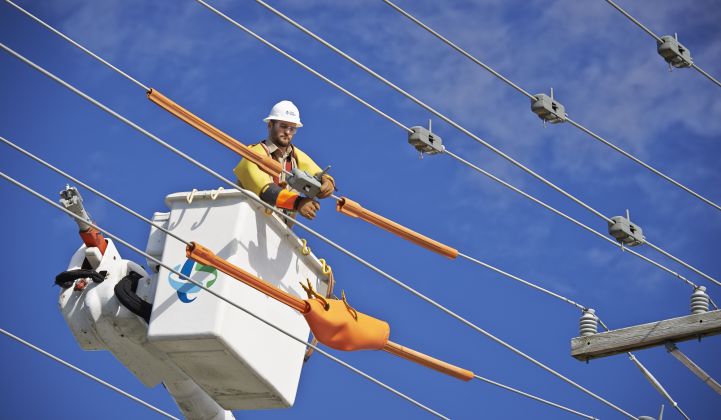Duke Energy is standing behind its plan to double its renewable energy base to 16 gigawatts by 2025 despite the depressing effect the coronavirus outbreak is having on its utilities.
Duke's first-quarter income from its utilities business fell, and the results don’t reflect the full impact of the COVID-19 stay-at-home and business closure orders, CEO Lynn Good said on a Tuesday conference call.
In April the picture darkened further: Duke's total electricity sales fell 5 percent, dragged down by a 12 percent slide in demand from industrial customers that was only partially offset by higher-than-usual residential sales.
Utilities across the country are reporting dramatic drops in commercial and industrial energy demand. Many are also absorbing the costs of continuing to serve residential customers who can’t pay their bills due to unemployment or sickness. Duke is among the largest U.S. power utilities, with 7.4 million electric and 1.4 million natural-gas customers across six states in the Southeast and Midwest.
Despite near-term headwinds, Duke stood behind its long-term plan to reach net-zero emissions by 2050, starting with a target of 50 percent greenhouse gas reductions by 2030. The utility group's plan to double its current 8 gigawatt fleet of renewables by 2025 is a big part of meeting those goals.
While renewables only account for 5 percent of Duke's 51 gigawatts of generating capacity today, its solar and wind portfolio has grown in recent years. Duke Energy Renewables, the company’s renewable energy development arm, owns projects in 19 states as far afield as California, competing with heavyweight developers like NextEra Energy and Avangrid.
In its home state of North Carolina, where state law allows Duke’s regulated utilities and its renewable development arm to compete against third-party independent power producers to supply solar power, the utility contracted 600 megawatts of solar last year and is bidding for 600 megawatts more this year, Duke spokesperson Randy Wheeless told GTM.
In Florida, a state that allows utilities to build their own solar power plants, Duke has about 300 megawatts of solar operating and another 200 megawatts under construction, part of a plan to reach 1,500 megawatts by 2028.
Coronavirus a "wild card"
Though the company does not currently expect the coronavirus pandemic to upend its renewable expansion plans, Duke is among numerous utilities and renewables developers grappling with a vast amount of uncertainty as the virus unfolds. “The goals we set, we still feel good about, but obviously the coronavirus is such a wild card [that] it could definitely change that,” Wheeless acknowledged.
The company is also dealing with the need to curtail solar generation amid lower-than-expected demand from large industrial and commercial customers, although so far the utility has only been forced to curtail its own solar plants rather than those of third-party developers, Wheeless said.
Duke's renewable energy business reported income of $57 million in the first quarter, a big jump from $13 million in the same quarter last year. That was mainly driven by the addition of about 1,500 megawatts of new projects last year, as well as favorable wind resource and power pricing, CFO Steve Young said in Tuesday’s conference call.
Duke's longer-term decarbonization plan relies on replacing old coal plants with natural gas, which is expected to rise from 35 percent of its generation mix in 2019 to 41 percent in 2030. That has brought opposition from environmental groups. Nuclear power is also set to play a big role, with Duke hoping to renew operating licenses for its 11 reactors to extend their lives by another two decades.
Unlike many other large-scale solar developers, Duke has built relatively little energy storage so far. But its 15-year integrated resource plan anticipates the addition of up to 300 megawatts of energy storage.
All told, Duke plans to invest $56 billion in capital infrastructure over the next five years, CEO Good said. That includes major grid investments such as its 10-year, $6 billion storm-hardening plans in Florida and a revamped grid modernization plan to replace one rejected by North Carolina regulators last year.
It also includes continued investment in natural-gas infrastructure, such as pushing ahead with the Atlantic Coast Pipeline natural-gas project, which has been put on hold under legal challenges that are now awaiting a hearing at the U.S. Supreme Court.




